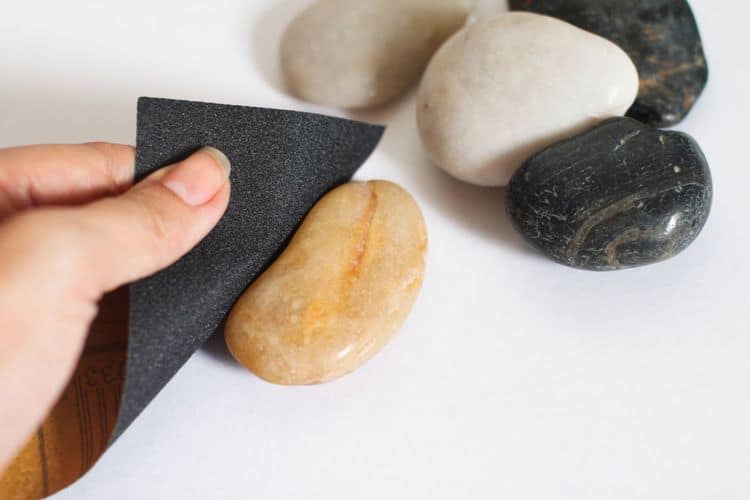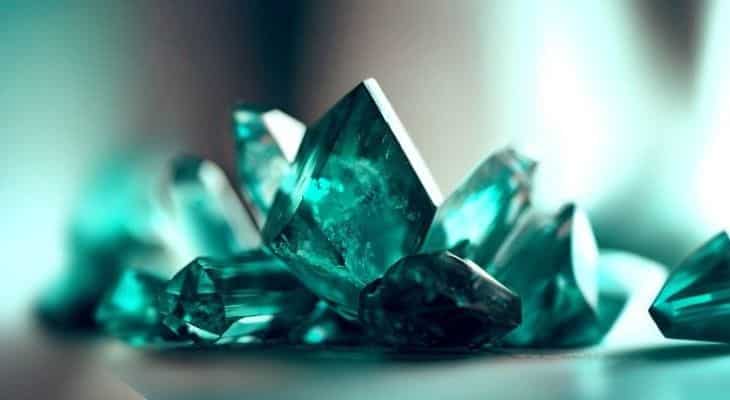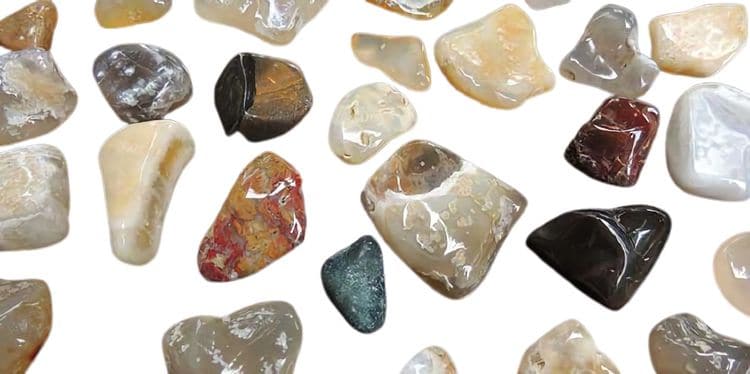Glittering like freshly fallen snow, white crystals and rocks have dazzled humankind since the dawn of civilization. From the milky luster of moonstone to the prismatic reflections of quartz, these minerals offer a window into the endless diversity of the natural world. This article will serve as your guide to identifying, appreciating, and working with some of Earth’s most mesmerizing white rocks and crystals.
We’ll begin by examining the unique properties of popular white minerals like quartz, calcite, and gypsum. You’ll learn how to distinguish between similar specimens by testing hardness, cleavage, crystal habit and other diagnostic features. Clear photos provide a visual showcase of these minerals’ signature forms and habits. For the lapidarist or collector, we’ll explain how to cut, polish, and set these intriguing materials into jewelry or display pieces.
Beyond the basics, you’ll also uncover fascinating facts and practical advice. Find out which ancient cultures prized white crystals and how they utilized them in tools, decoration, and trade. Learn how scattering, absorption, and other optical phenomena impart color and luster. Discover professional tips for properly displaying and lighting your white mineral collection. This article illuminates both the science and beauty of some of nature’s most luminous creations. So grab your hand lens and let’s explore some of Earth’s whitest rocks and crystals!
White crystals and rocks names
Here is a list of white rocks, stones, and minerals with brief descriptions and tips for distinguishing between them. Please note that there are many more minerals and rocks that can appear white, and this list is not exhaustive.
- Quartz – Quartz is a mineral that is often white or colorless. It has a hardness of 7 on the Mohs scale and is one of the most common minerals in the Earth’s crust. Quartz can be distinguished from other white minerals by its hardness, crystal habit (usually six-sided prisms), and lack of cleavage.
- Calcite – Calcite is a mineral that is often white or colorless, and is easily recognized by its rhombohedral cleavage. It has a hardness of 3 on the Mohs scale and effervesces with acid. Calcite can be distinguished from other white minerals by its cleavage, low hardness, and reaction to acid.
- Gypsum – Gypsum is a mineral that is often white or colorless, and is easily recognized by its softness (hardness of 2 on the Mohs scale) and silky luster. Gypsum can be distinguished from other white minerals by its softness, silky luster, and tendency to form elongated crystals.
- Kaolinite – Kaolinite is a clay mineral that is often white or pale-colored. It has a hardness of 2-2.5 on the Mohs scale and is known for its pearly luster. Kaolinite can be distinguished from other white minerals by its low hardness, pearly luster, and tendency to form platy or layered aggregates.
- Halite – Halite, also known as rock salt, is a mineral that is often white or colorless. It has a hardness of 2.5 on the Mohs scale and is easily recognized by its cubic cleavage and salty taste. Halite can be distinguished from other white minerals by its cubic cleavage and salty taste.
- Barite – Barite is a mineral that is often white or colorless, and has a hardness of 3-3.5 on the Mohs scale. It is easily recognized by its high specific gravity and tendency to form tabular or prismatic crystals. Barite can be distinguished from other white minerals by its high specific gravity and crystal habit.
- Fluorite – Fluorite is a mineral that can be white or many other colors, and has a hardness of 4 on the Mohs scale. It is easily recognized by its octahedral or cubic crystal habit, and can be fluorescent under UV light. Fluorite can be distinguished from other white minerals by its crystal habit and fluorescence.
- White sapphire is a precious gem valued for its durability. It ranks just below diamonds in hardness and exhibits a pure white color when free of impurities. White sapphires are used in engagement rings and other fine jewelry.
- White topaz can form in massive compact stones or prismatic crystals. While often colorless, some white topaz contains cloud-like inclusions that give it a desirable milky or pearly cast. Topaz has a vitreous luster.
- Moonstone displays a bluish sheen called adularescence. Its soft glow is said to be healing and protective. The best moonstones have a transparent body color and vivid blue adularescence.
- White agate, a form of chalcedony, forms in botryoidal grape-like clusters or bands. Agate from Indonesia often contains delicate black tree-like veins, giving it visual depth.
- White jade is one of the purest forms of jadeite, a tough, smooth-textured gemstone. It occurs in translucent and opaque varieties and is carved into beads, figurines, and more.
As a lapidary artist, I adore working with white gemstones to create unique jewelry pieces. The various textures, patterns, and translucency found across these stones provide endless inspiration. White gems also create soothing, neutral color palettes when combined with metal settings. I’ve used white quartz and topaz to craft popular wire-wrapped pendants.
Table Comparing White Crystals and Rocks
| Mineral | Color | Hardness | Cleavage/Habit | Special Characteristics |
|---|---|---|---|---|
| Quartz | White | 7 | Six-sided | Lack of cleavage |
| Calcite | White | 3 | Rhombohedral | Effervesces with acid |
| Gypsum | White | 2 | Elongated | Softness, silky luster |
| Kaolinite | White | 2-2.5 | Platy | Pearly luster |
| Halite | White | 2.5 | Cubic | Salty taste |
| Barite | White | 3-3.5 | Tabular | High specific gravity |
| Fluorite | White | 4 | Octahedral | Fluorescent under UV light |
I hope this information is helpful and informative for you. Keep in mind that while these minerals and rocks may appear white, they can also come in various shades and colors due to impurities or other factors.
In addition to the minerals and rocks listed above, there are many others that can appear white, including feldspar, mica, and talc, among others. Feldspar can be distinguished from other white minerals by its two cleavage planes, while mica can be distinguished by its thin, flexible, and elastic nature. Talc can be distinguished by its greasy or soapy feel and low hardness.
It’s worth noting that distinguishing between different white minerals can sometimes be difficult, as they can share similar physical properties. It’s important to use a combination of characteristics, such as hardness, cleavage, color, and crystal habit, to make a proper identification. It’s also helpful to consult a mineral guide or seek the advice of a professional lapidarist or geologist.
In conclusion, white minerals and rocks are a common sight in nature, and can be found all over the world. Each of the minerals listed above has its own unique characteristics that make it distinct from other white minerals, and proper identification can be achieved through careful observation and testing.
White Gemstones
White gemstones encompass a diverse array of metamorphic rocks, minerals, and crystals that exhibit light cream, off-white, or snowy hues.
Popular varieties include:
- White jasper, an opaque metamorphic rock with earthy patterns and tones. It promotes courage and protection.
- Howlite, a borate mineral with swirling gray or black veining. It has a calming, soothing energy.
- White moonstone displays a bluish shimmer called adularescence. It represents new beginnings and inner growth.
- Milky white quartz is hazy and translucent due to air bubbles and inclusions. It enhances meditation and clarity.
- White calcite forms in massive, chunky pieces with a vitreous luster. It amplifies energy and clears stagnant vibrations.
As a lapidary artist, I often wire wrap or bead white crystals and stones into jewelry. The neutral palette allows the gemstones’ natural textures and patterns to take center stage.
One of my favorite pieces is a wire wrapped white prehnite pendant. Prehnite has a tranquil energy that promotes inner peace. I hand chose the stone for its smooth, rounded cabochon cut and snowy white color with faint green veins.
White gemstones pair beautifully with silver, white gold, or neutral-toned metals. They make exceptional additions to any crystal healing practice or gemstone collection.
How to identify white crystals and rocks
Here are some step-by-step instructions for identifying white crystals and rocks:
- Examine the color: Observe the color of the specimen. Is it white or off-white? Are there any other colors or hues present?
- Test the hardness: Test the hardness of the specimen by scratching it with a mineral of known hardness. The Mohs hardness scale can be used to identify the hardness of minerals, ranging from 1 (softest) to 10 (hardest). For example, if the specimen can be scratched with a fingernail, its hardness is less than 2.5 on the Mohs scale.
- Look for cleavage: Observe the specimen for cleavage, which refers to how the crystal or rock breaks. Does it break along smooth planes or does it fracture irregularly? Cleavage can be a useful diagnostic tool in identifying minerals.
- Examine the crystal habit: Observe the shape and form of the crystal or rock. Does it have a distinctive shape or form? Some minerals have a characteristic crystal habit, such as six-sided prisms (quartz) or tabular crystals (barite).
- Conduct acid testing: For some white minerals, such as calcite, effervescence (bubbling) occurs when they come into contact with an acid such as vinegar. If the specimen effervesces when exposed to acid, it may be calcite or another mineral that reacts in a similar way.
- Consult reference materials: Consult mineral guides or other reference materials to compare your observations with known characteristics of white minerals and rocks. These resources can be used to narrow down possible identifications and provide more information about the specimen.
- Seek professional advice: If you are unsure of the identification or need additional assistance, seek the advice of a professional lapidarist, geologist, or mineralogist. They can provide more specialized knowledge and help identify the specimen accurately.
In conclusion, identifying white crystals and rocks requires a combination of observations and tests. By using these steps, you can narrow down possible identifications and determine the properties and characteristics of the specimen. Remember that identifying minerals and rocks can sometimes be challenging, so it’s always helpful to consult reference materials or seek professional advice when in doubt.
Interesting facts
Here are some interesting facts about white crystals and rocks:
- Quartz is one of the most common white minerals found in the Earth’s crust, and it has been used for thousands of years in jewelry, tools, and other objects.
- Diamonds, one of the hardest known substances, are often clear or white in color, though they can also be found in other colors.
- The largest pearl ever found, known as the Pearl of Lao Tzu, is white and weighs over 14 pounds.
- Moonstone, a type of feldspar, is a popular gemstone that can exhibit a phenomenon known as adularescence, which creates a shimmering effect reminiscent of moonlight.
- Gypsum, a common white mineral, is used in a wide range of applications, including construction, fertilizer, and as a food additive.
- Calcite, another common white mineral, is found in a wide range of forms, including stalactites, stalagmites, and geodes.
- Opals, a type of silica mineral, can exhibit a range of colors, but white opals are highly prized for their iridescent play of color.
- Many white rocks, such as marble and limestone, have been used for centuries in architecture, sculpture, and other art forms.
- White granite, a type of igneous rock, is highly valued for its durability and beauty, and is used in a wide range of applications, from building facades to kitchen countertops.
- The purest form of natural salt, Himalayan salt, is often white or pink in color and is believed by some to have a range of health benefits.
These are just a few of the many interesting facts about white crystals and rocks!
Color explanation
First, let’s talk about what white actually means in the context of crystals and rocks. When we see an object as white, what we are really seeing is a combination of all colors of light reflecting back to our eyes. This is because white light is made up of all the colors of the rainbow, and when it strikes an object, the different colors are either absorbed or reflected. If all colors are reflected, we see the object as white.
Now, when it comes to crystals and rocks, there are several reasons why they may appear white:
- High Reflectance: Some minerals have a high reflectance, which means they reflect most of the light that hits them. This can create a bright, white appearance. Minerals like calcite, quartz, and feldspar are known for their high reflectance.
- Lack of Color: Some minerals simply do not have any pigment, and are therefore colorless. This lack of color can make them appear white. Examples of colorless minerals include gypsum and barite.
- Translucence: Some minerals are translucent, which means that light can pass through them. When light passes through a translucent mineral, it can scatter in all directions, creating a white appearance. Examples of translucent minerals that can appear white include talc and apatite.
- Physical Properties: Some minerals can appear white due to their physical properties. For example, the mineral halite (rock salt) appears white because it is composed of tiny, cubic-shaped crystals that reflect light in all directions.
- Geological Processes: Finally, some rocks can appear white due to the geological processes that formed them. For example, chalk is a sedimentary rock that is composed of the remains of tiny marine organisms. These organisms had white skeletons, which is why the rock appears white.
In summary, there are many reasons why crystals and rocks can appear white. These can include high reflectance, lack of pigment, translucence, physical properties, and geological processes. As a Lapidarist, it’s always fascinating to explore the many factors that can influence the appearance of minerals and rocks, and the color white is just one example of the rich diversity of the world of lapidary.
FAQ
What causes some crystals and rocks to be white?
The color of a mineral or rock is determined by its chemical composition and the way light interacts with it. White minerals and rocks are typically composed of lighter-colored minerals, such as quartz or feldspar, and may contain impurities or other factors that affect their color.
How can I tell the difference between white minerals?
Distinguishing between different white minerals can be challenging, as they can share similar physical properties. It’s important to use a combination of characteristics, such as hardness, cleavage, color, and crystal habit, to make a proper identification. It’s also helpful to consult a mineral guide or seek the advice of a professional lapidarist or geologist.
Are all white minerals and rocks opaque?
No, not all white minerals and rocks are opaque. Some, such as calcite, may be translucent or even transparent. The level of transparency can also vary depending on the thickness of the specimen.
Can white minerals and rocks be used for jewelry?
Yes, white minerals and rocks can be used for jewelry. Some popular options include quartz, pearl, moonstone, and opal, among others.
Are white crystals and rocks rare?
White minerals and rocks are not necessarily rare, as they can be found all over the world. However, the rarity of a mineral or rock depends on its specific properties and geological context.
How can I clean and care for my white crystal or rock?
The cleaning and care of a white crystal or rock will depend on the specific mineral or rock type. Some may be sensitive to water or certain cleaning agents, so it’s important to research the best cleaning methods for your specimen. In general, it’s a good idea to handle your specimen with care and avoid exposing it to extreme temperatures or direct sunlight, which can cause damage over time.
Conclusion
White crystals and rocks are truly remarkable specimens, with a wide range of colors, textures, and properties. Whether you’re a lapidarist, geologist, or simply an enthusiast, understanding these minerals and rocks can provide valuable insights into the natural world around us. By using the steps outlined in this article, you can begin to explore the fascinating world of white crystals and rocks and learn more about their unique properties and characteristics.




Leave a Reply